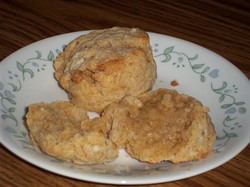
If you’re using whole-wheat flour instead of all-purpose flour, there are a couple things to know for successful baking. Whole grains contain fiber-rich bran and nutrient-rich germ, as well as the starchy endosperm. Processed white flour contains only the starchy part, not the bran or germ. Because of this, you'll need to adjust your ingredients a little bit, either reduce the amount of flour by 2-3 Tbsp. per cup used, OR increase liquid by 3-4 Tbsp. per cup used and increase leavening by about 1/3. Otherwise, your baked goods will be more dense, heavy, and flat than they need to be. See more on this below.
Bran is the outer protective layer of the kernel, it's very high in fiber and minerals, and vitamins. That fiber is very absorbent. Because of this, whole wheat flour (measured by weight) absorbs about 25% more liquid than processed white flour does. Bran also makes it harder for gluten to form; its sharp edges tend to cut the tiny gluten strands. Soaking the dough – mixing at least the flour and liquid, then letting it sit for a few hours or overnight - softens the bran. That’s one reason European breads have long rise times. The technique works well for pancake batter and cake batter- leave eggs out of the batter until ready to bake, or soak covered in the refrigerator.
The germ is also high in vitamins and minerals, as well as protein, some fiber and fat (vitamin E). Its name comes from the same Latin root as the word "germinate"; germen , which means to sprout or shoot. The germ is the part of the grain that can grow into a plant. It is dense and heavy, and therefore you'll need more leavening in the recipe. The vitamin E, which is an oil, is the reason for whole wheat flour's short shelf life; this type of fat oxidizes quickly, which makes it slightly rancid. Store fresh-ground flour in the fridge or freezer to prolong its life and vitamin content. If you leave the flour at room temperature, it's at its best within 24 hours, but is still good (though less nutritious) for about a week. It won't make you sick after that, just won't give you all the benefits it would have when more fresh. Neither does it taste as good. That's why bread made from freshly ground flour tastes so much better than bread made with whole wheat flour from a bag at the store.
To recap:
either use about 20% less flour (2-3 Tbsp. less per cup used),
or increase water by about 3-4 Tbsp. per cup of liquid and add about 1/3 more of any leavening agent you’re using (1 tsp. more per Tbsp).
Fresh-ground flour is fluffy and less packed in the cup, so there’s already less there. For the most accurate measuring, go by weight, not volume.
 RSS Feed
RSS Feed